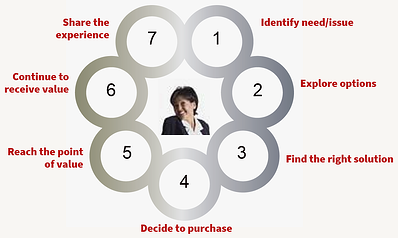In our last post, we discussed why customer experience is such a vital part of your marketing mix.
To take it a step further, let’s now consider some best practices that you can start applying right now to create a powerful customer experience in your own company.
1. Define the customer journey and touch points
Remember, the hallmark of a great customer experience is consistency across all customer touch points. Although each organization’s exact customer journey will be a little different, and some customers will follow a more unpredictable path, the general customer journey is outlined as follows:

- Identify the Need/Issue – A consumer realizes that they have a problem that needs a solution and/or a hole that needs to be filled. They begin searching for the right fit.
- Explore Options – The consumer has unlimited information at their fingertips and will often spend a considerable amount of time comparing various products, manufacturers, and service providers.
- Find the Right Solution – In some cases, the right solution is readily apparent. At other times, it comes down to an emotional “gut” decision after taking in all the information available. The consumer moves forward with more in-depth research on the particular provider, product, or service they're considering.
- Decide to Purchase – Up until this point, the consumer has an out. Even if they’ve become emotionally invested in the product or service they’ve chosen, until they make the decision to purchase, they can still call it off and move on to the competition.
- Reach the Point of Value – The consumer has made their purchase and received their product and/or service. This is where many relationships fall apart because the consumer is disappointed by some aspect of the situation: the item is not what they expected, it does not live up to the marketing claims they have relied upon, or it works fine but does not provide sufficient value for the price paid.
- Continue to Receive Value – Assuming point five was passed without an issue, this point indicates the consumer has remained satisfied over the long haul. They have gotten all they expected and more from the purchase they made, and they’re truly impressed.
- Share the Experience – The consumer offers a priceless recommendation to friends, family, and a wider social network, to buy the product or service. This is the ultimate goal of a positive customer experience and is worth more than any other kind of marketing or promotional efforts you can invest in.
Along every step of this journey, your brand interacts in some way with that consumer. For example, at Stage 1-3, your services/products must be visible wherever that individual is likely to start looking for help. With the Internet being the first stop in most consumers’ journey these days, a comprehensive online presence is vital. Likewise, any other means by which prospects can get a glimpse at your company must be equally up to the challenge, including the look and feel of every storefront.
In stage 4, touch points become even more important as the consumer narrows in on a buying decision. Online, every step of the buying process should be as seamless, fast, and secure as possible, reducing all hindrances to the consumer going ahead with the purchase. Any other interactions the consumer has with store personnel or other brand representatives need to reinforce a positive customer experience.
In stages 5 and 6, a quality product or service, courteous initial service, and fantastic customer service during and after the sale all play a part. Also, any educational material, tutorials, or other beneficial content that can help the consumer get the very most they can out of their purchase will add tremendous value.
Finally, make stage 7 easy and smooth by providing delighted customers with a way to share their experiences.
All of these stages – and the individual touch points that are weaved through them – are unique to each company, and must be fully understood and properly managed to maintain a consistent positive customer experience.
2. Define the brand promise and deliver on it
While it may seem like an exercise in semantics, a “brand promise” is different from the company’s mission or goals. The brand promise is the claim that your brand makes to set it apart from all other brands.
A consistent customer experience must start with a clear brand promise. If you do not know your brand promise, how could your customers know what it is? How can your brand fulfill their needs if gaps exist between what you should be doing to deliver on a promise and what you’re actually doing?
Your brand promise will draw customers to you in stages 1-3, will strengthen their resolve in stage 4, and will better ensure your brand’s success in stages 5-7.
3. Commit to measuring customer experience and its impact on consumer behavior
Unless you commit to identifying, tracking, and analyzing the right metrics to measure your customer experience, you’ll never have a clear understanding of your customer experience or how it can be improved. Once you make that commitment, you’ll be in an excellent position to maintain customer happiness and sucess.
So, in conclusion,
- Define your customer journey and touch points
- Define your brand promise and deliver on it
- Commit to measuring customer experience
By following these three best practices, your brand will be in an excellent position to offer a quality, consistent customer experience across the board that will attract new customers routinely and keep your existing customers coming back for more.


